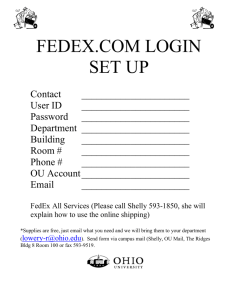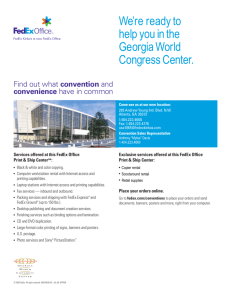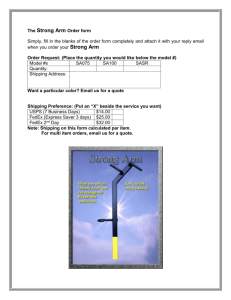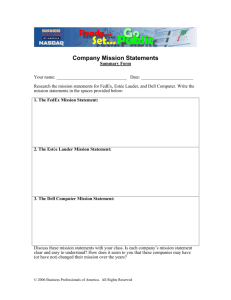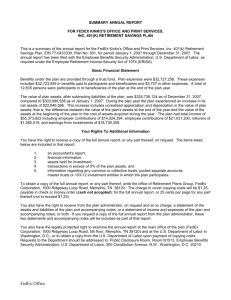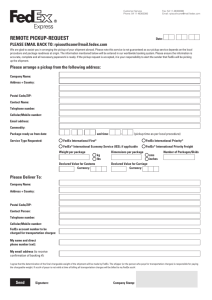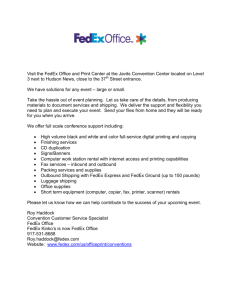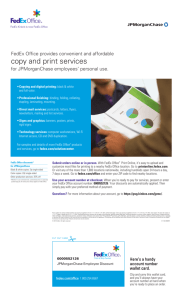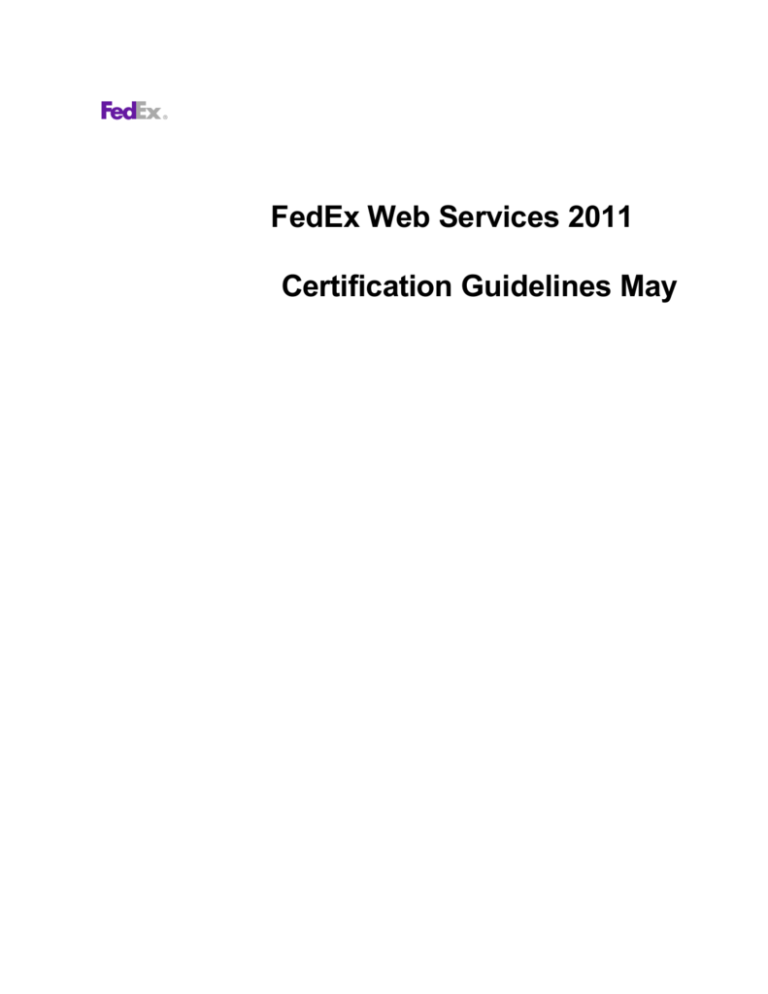
FedEx Web Services 2011
Certification Guidelines May
Payment
You must remit payment in accordance with the FedEx Service Guide, tariff, service
agreement or other terms or instructions provided to you by FedEx from time to time. You
may not withhold payment on any shipments because of equipment failure or for the failure of
FedEx to repair or replace any equipment.
Inaccurate Invoices
If you generate an inaccurate invoice, FedEx may bill or refund you the difference according to
the FedEx Service Guide, tariff service agreement or other terms or instructions provided to
you by FedEx from time to time. A request for refund on a FedEx® shipment must be made in
accordance with the applicable Service Guide, or terms or instructions provided by FedEx from
time to time. A shipment given to FedEx with incorrect information is not eligible for refund under
any FedEx money-back guarantees. FedEx may suspend any applicable money-back
guarantees in the event of equipment failure or if it becomes inoperative.
Confidential and Proprietary
The information contained in the FedEx Web Services Certification Guide is confidential and
proprietary to FedEx Corporate Services, Inc. and its affiliates (collectively “FedEx”). No part of
this Certification Guide may be distributed or disclosed in any form to any third party without
written permission of FedEx. This guide is provided to you under and its use is subject to the
terms and conditions of the FedEx End User and/or Consultant License Agreement. The
information in this document may be changed at any time without notice. Any conflict between
either of these guides, the FedEx End User and/or Consultant License Agreement, and the
FedEx Service Guide shall be governed by the FedEx End User and/or Consultant License
Agreement and the FedEx Service Guide, in that order.
©2011 FedEx. FedEx and the FedEx logo are register service marks. All rights reserved.
Unpublished.
2
Contents
Foreword ............................................................................................................................................ 4
Audience ................................................................................................................................... 4
Scope........................................................................................................................................ 4
Prerequisites ........................................................................................................................................... 4
Related Documents................................................................................................................................. 4
Document Conventions........................................................................................................................... 5
Support ..................................................................................................................................... 5
United States...................................................................................................................................................5
Canada.................................................................................................................................. 5
LAC (Latin America and the Caribbean) .................................................................................... 5
EMEA (Europe, Middle East, Africa and Indian sub-continent)................................................. 5
APAC (Asia-Pacific)....................................................................................................................... 5
Introduction ..............................................................................................................................................................6
Document Organization .......................................................................................................................... 6
Starting the Certification Process ...................................................................................................... 7
Corporate Developer Certification ..................................................................................................... 8
Certifying Applications with Standard FedEx Web Services......................................................... 9
Certifying Applications Using Advanced FedEx Web Services without Shipping Labels..........11
Certifying Applications Using Advanced FedEx Web Services with Shipping Labels...............13
Consultant Developer Certification ................................................................................................. 15
Updating Production Credentials .................................................................................................... 17
3
Foreword
This document describes how to certify a FedEx Web Services enabled application.
Audience
This document is intended for developers who have created and tested FedEx Web Services
enabled applications, and who need FedEx certification before moving applications to
production.
Note: The certification procedures described in this document do not apply to commercial
developers (software providers or parties that resell and/or distribute a FedEx integration
solution). Commercial developers must be accepted to the FedEx Compatible Solutions
Program (CSP) and comply with its terms. See fedex.com/us/compatiblesolutions/provider/ for more information.
Scope
This document describes the step-by-step process required to certify FedEx Web Services
enabled applications and how to move them to production.
Prerequisites
You must be familiar with FedEx Web Services and be able to successfully develop and test
applications in the FedEx Web Services testing environment.
Related Documents
The following documents contain information related to this certification guide:
FedEx Service Guide at http://fedex.com/us/services/pdf/
FedEx Web Services Developer Guide at
https://www.fedex.com/wpor/web/jsp/drclinks.jsp?links=wss/index.html
Web Services Online Help at
https://www.fedex.com/wpor/web/jsp/drclinks.jsp?links=wss /index.html
4
Document Conventions
This document uses the following conventions to help you understand the different types of
content:
Code samples and information that you need to enter is formatted in Courier New
Important notices begin with the word Note
The names of user interface elements appear in bold
Italics are used for emphasis, new terms, book titles, and transaction names
Links to various information are formatted like this: fedex.com/developer
Support
Contact FedEx support based on the region in which your FedEx Account is supported.
United States
Technical Support hotline phone: 1.877.339.2774 (When prompted, please say "Web Services")
Pre-Production Assistance: FedEx Web Integration Solutions Consultation Team
If you are in the pre-production stages of implementing a FedEx web integration solution and
would like to speak with a FedEx employee, who can assist you in understanding FedEx Web
Services, contact your aligned FedEx account executive or the technical support number:
1.877.339.2774 (Monday-Friday 7 a.m.-9 p.m., Saturday 9 a.m.-3 p.m. (CST).
Canada
Technical Support hotline phone: 1.877.339.2774
LAC (Latin America and the Caribbean)
Brazil: ct-hdesk@mail.fedex.com
All other countries within LAC: helpdesk@fedex.com
EMEA (Europe, Middle East, Africa and Indian sub-continent)
Technical Support: emeawebservices@fedex.com
APAC (Asia-Pacific)
Technical Support: apacwebservices@fedex.com
5
Introduction
FedEx Web Services enabled applications must be certified before being moved into
production. Certification is the process of determining if your implementation meets a number of
requirements to achieve the safe, secure, and effective operation of your solution in the FedEx
production environment.
The basic application development process includes design, development, testing, certification,
and production. This document provides detailed procedures for the certification process.
Note: The certification procedures described in this document do not apply to commercial
developers (software providers or parties that resell and/or distribute a FedEx integration
solution). Commercial developers must be accepted to the FedEx® Compatible Solutions
Program and comply with its terms. See http://www.fedex.com/us/compatiblesolutions/provider/ for more information.
See the FedEx Developer Resource Center at http://www.fedex.com/developer for more
information about developing and testing Web Services enabled applications.
Document Organization
This document is organized in a tree structure, branching out from the top as follows:
Corporate developer
o Standard Web Services
o Advanced Web Services
o Advanced Web Services with Shipping Labels
Consultant developer
Start at the next section, Starting the Certification Process to find your certification procedure.
6
Starting the Certification Process
For certification purposes there are two types of developers:
Corporate developer: You are developing FedEx Web Services enabled applications
directly for your employer or for the business entity that you own. This document uses
corporate developer and developer interchangeably. Corporate developers must be
creating applications for a company with a FedEx account and a signed End-User
License Agreement (EULA).
Consultant Developer: You are a third-party consultant developing Web Services
enabled applications on behalf of a FedEx customer. This document uses consultant
developer and consultant interchangeably. Consultant developers (including
independent consultants and other third parties) and their clients must execute a FedEx
End-User License Agreement (EULA).
To find the certification process for your Web Services enabled application, select your role:
Corporate Developer
Consultant Developer
7
Corporate Developer Certification
This chapter describes the process for certifying FedEx Web Services enabled applications created
by corporate developers. The certification process varies based on the FedEx Web Services
type:
Standard Web Services ‐ Applies to rating, rate available services, service availability,
tracking, signature proof of delivery, shipment notification, and drop-off locator
applications.
Advanced Web Services without shipping labels ‐ Applies to courier dispatch,
shipment validation, close shipment, reprint close report and address validation
applications.
Advanced Web Services with shipping labels ‐ Applies to ship, cancel ship, express tag,
cancel express tag, ground call tag, cancel ground tag, email label, and cancel email
label applications.
Select your application:
Standard
Advanced without Labels
Advanced with Labels
8
Certifying Applications with Standard FedEx Web
Services
Standard FedEx Web Services enabled applications may include the following depending on
your location:
FedEx Rating
FedEx Rate Available Services
FedEx Service Availability
FedEx Tracking
FedEx Signature Proof of Delivery
FedEx Shipment Notification
FedEx Drop-off Locator
Note: FedEx Web Services Developer Guide for FedEx Web Services availability by location.
Log in to the FedEx Developer Resource Center at http://www.fedex.com/developer and go to
the Get Started page
https://www.fedex.com/wpor/web/jsp/drclinks.jsp?links=wss/getstarted.html for an up-to-date list
of standard web services.
Corporate developers must complete the following steps to certify standard Web Services
enabled applications.
Step 1. Develop and Test Web Services Enabled Application
Develop and test your standard Web Services enabled application. Complete testing using the
test authentication credentials (test account number, test meter number, developer test key and
test security password) Your password was sent via a separate email communication.
Step 2. Register for Move to Production
Start the certification process by applying for a FedEx production meter number at the FedEx
Developer Resource Center.
Step 3. Obtain Production Credentials
Obtain your production credentials (production meter number, production authentication key and
production security password) online during the registration process. Your password was sent
via a separate email communication.
Important Note: Due to the sensitivity of this information, the production authentication key is
not provided in the confirmation email (Step 4). Please retain this information for your
records.
Step 4. Receive Confirmation Email
You will receive confirmation of your registration by email.
Step 5. Standard Applications Are Automatically Enabled
Standard FedEx Web Services transactions are automatically enabled for production.
9
Step 6. Replace URL and Credentials
Replace the test URL and test credentials with the production URL and production credentials.
For detailed instructions please see Updating Production Credentials in this document.
This completes the certification process and moves your application to production.
Note: It is recommended that you immediately test the production version of the application
using sample data.
For information about technical support at your location, see Support.
10
Certifying Applications Using Advanced FedEx Web
Services without Shipping Labels
Advanced Web Services enabled applications without shipping labels may include the following
depending on your location:
Courier Dispatch
Address Validation
Email Label
Note: FedEx Web Services Developer Guide for FedEx Web Services availability by location.
Log in to the FedEx Developer Resource Center at http://www.fedex.com/developer and go to
the Get Started page
http://www.fedex.com/wpor/web/jsp/drclinks.jsp?links=wss/getstarted.html for an up-to-date list
of standard Web Services.
Corporate developers must complete the following steps to certify advanced Web Services
applications without shipping labels.
Step 1. Develop and Test Web Services Enabled Application
Develop and test your advanced Web Services application without shipping labels. Complete
testing using the test authentication credentials (test account number, test meter number,
developer test key and developer test security password). Your password was sent via a
separate email communication.
Step 2. Register for Move to Production
Start the certification process by applying for a FedEx production meter number at the FedEx
Developer Resource Center.
Step 3. Obtain Production Credentials
Obtain your production credentials (production meter number, production authentication key and
production security password) online during the registration process. Your password was sent
via a separate email communication.
Note: A production meter number is required for each of your locations. It is acceptable to use
the same authentication key and password among multiple locations.
Important Note: Due to the sensitivity of this information, the production authentication key is
not provided in the confirmation email (Step 4). Please retain this information for your
records.
Step 4. Receive Certification Instructions
You will receive confirmation of your registration by email.
11
Step 5. Contact the Regional Web Integration Solutions (WIS) Support Team
Contact the Web Integration Solutions Team for your region with your application information
and production credentials. Request that your application be enabled using advanced Web
Services without shipping labels.
For a complete list of regional support contact information see Support in this document.
Step 6. Regional WIS Team Enables the Application
The support team authorizes your profile to transmit the identified advanced Web Services
application. Once the application is enabled, the WIS team will send you an e-mail confirming
your production status.
Step 7. Replace URL and Credentials
Replace the test URL and test credentials with the production URL and production credentials.
For detailed instructions see Updating Production Credentials.
This completes the certification process and moves your application to production.
Note: It is recommended that you immediately test the production version of the application
using sample data.
For information about technical support at your location, see Support.
12
Certifying Applications Using Advanced FedEx Web
Services with Shipping Labels
Advanced Web Services enabled applications with shipping labels include the following:
FedEx Ship
FedEx Cancel Ship Express Tag
FedEx Cancel Express Tag
FedEx Ground Call Tag
FedEx Cancel Ground Tag
FedEx Email Label
FedEx Cancel Email Label
FedEx Pending Shipment
See the FedEx Web Services Developer Guide to see FedEx Web Services availability by
location.
Log in to the FedEx Developer Resource Center at http://www.fedex.com/developer and go to
the Get Started page
http://www.fedex.com/wpor/web/jsp/drclinks.jsp?links=wss/getstarted.html for an up-to- date list
of standard Web Services.
Corporate developers in the U.S. and Canada must complete the following steps to certify
advanced Web Services applications with shipping labels.
Step 1. Develop and Test Web Services Enabled Application
Develop and test your advanced Web Services application with shipping labels. Complete
testing using the test authentication credentials (test account number, test meter number,
developer test key and security password). Your password was sent via a separate email
communication.
Step 2. Register for Move to Production
Start the certification process by applying for a FedEx Production Meter Number at the FedEx
Developer Resource Center.
Step 3. Obtain Production Credentials
Obtain your production credentials (production meter number, production authentication key and
production security password) online during the registration process. Your password was sent via
a separate email communication.
Note: A production meter number is required for each of your locations. It is acceptable to use
the same authentication key among multiple locations.
13
Important Note: Due to the sensitivity of this information, the production authentication key is
not provided in the confirmation email (Step 4). Please retain this information for your records.
Step 4. Receive Confirmation Email
You will receive confirmation of your registration by email.
Step 5. Contact the Regional Web Integration Solutions (WIS) Support Team
Contact the Web Integration Solutions Team for your region with your application information
and production credentials. Request that your application be enabled using advanced Web
Services with shipping labels.
For a complete list of regional support contact information see Support in this document
Step 6. Regional WIS Team Provides Instructions for Submitting Labels
The support team of your region sends an email with instructions for certifying labels generated
by your application.
Step 7. Generate and Submit Test Labels
Generate test labels associated with the application and submit the test labels to the FedEx
label evaluation teams for approval.
Note: The FedEx label evaluation teams require a five-day turn-around time for label evaluation.
Step 8. Label Evaluation
The FedEx label evaluation teams evaluate the submitted test labels and approves or rejects
the labels. The support team member in your region contacts you regarding the approval or
rejection of the submitted labels. If the labels are approved, continue to the next step. If the
labels are rejected, correct the labels as instructed and resubmit them for approval.
Step 9. Regional WIS Team Enables the Application
Once the test labels are approved for production status by the label evaluation teams, the
support team member for your region authorizes your profile to transmit the identified shipping
label transaction and notifies you of successful certification.
Step 10. Replace URL and Credentials
Replace the test URL and test credentials with the production URL and production credentials.
For detailed instructions see Updating Production Credentials.
This completes the certification process and moves your application to production.
Note: It is recommended that you immediately test the production version of the application
using sample data.
For information about technical support at your location, see Support.
14
Consultant Developer Certification
This section describes the process required to certify Web Services enabled applications
created by consultant developers.
See the FedEx Web Services Developer Guide for FedEx Web Services availability by
location.
Log in to the FedEx Developer Resource Center at http://www.fedex.com/developer and go to
the Get Started page
http://www.fedex.com/wpor/web/jsp/drclinks.jsp?links=wss/getstarted.html for an up-to- date list
of standard Web Services.
Consultants must complete the following steps to certify Web Services enabled applications.
Step 1. Develop and Test Web Services Enabled Application
Develop and test your Web Services enabled application. Complete testing using the test
authentication credentials (test account, test meter number, developer test key and security
password).Your password was sent via a separate email communication.
Step 2. Register for Move to Production
Start the certification process by applying for a FedEx production meter number at the
Developer Resource Center.
Step 3. Obtain Production Credentials
Obtain your production credentials online during the registration process.
Note: A production meter is required for each of your locations. It is acceptable to use the same
authentication key and security password among multiple locations.
Important Note: Due to the sensitivity of this information, the production authentication key is
not provided in the confirmation email (Step 4). Please retain this information for your
records. The authentication key must also be provided to the FedEx customer for whom
you are developing your application.
Step 4. Receive Confirmation Email
As a consultant you will receive confirmation of your registration by email. The FedEx customer
for whom you are developing your application will also receive a confirmation email that a
consultant has registered on their behalf.
Step 5. Contact the Regional Web Integration Solutions (WIS) Support Team
Contact the support team member for your region with your application information and
production credentials to request that your advanced Web Services application with Shipping
Labels be enabled.
For information about technical support at your location, see Support.
15
Step 6. Regional WIS Team Emails Instructions for the End-User License Agreement
(EULA)
The support team sends an email entitled "FedEx Web Services – EULA Submission" to the
your end customer. This email instructs the end customer to complete the EULA and return it to
the support team.
Step 7. Regional WIS Team Receives EULA
The support team receives the EULA from the end customer.
Step 8. Regional WIS Team Enables Application or Requests Test Label
If the application is standard, or advanced without labels, it is manually enabled by the support
team. In this case, proceed to step 13. If the application is advanced with shipping labels,
continue to the next step.
Step 9. Receive Instructions for Submitting Labels
The regional support team sends an email to the consultant with instructions to generate
specific test labels associated with the application and to submit the test labels to the FedEx
label evaluation teams for approval.
Note: The FedEx label evaluation teams require a 5-day turn-around time for label evaluation.
Step 10. Generate and Submits Test Labels
The consultant generates test labels associated with the application and submits the labels for
certification.
Step 11. Label Evaluation
The FedEx label evaluation teams evaluate the submitted test labels and approve or reject the
labels. The regional support team contacts you regarding the approval or rejection of the
submitted labels. If the labels are approved, continue to the next step. If the labels are rejected,
correct the labels as instructed and resubmit them for approval.
Step 12. Regional WIS Team Enables the Application
Once the test labels have been approved for production by the label evaluation teams, the
support team authorizes your profile to process the identified transaction and notifies you of
successful certification.
Step 13. Replace URL and Credentials
Replace the test URL and test credentials with the production URL and production credentials.
For detailed instructions see Updating Production Credentials. This completes the certification
process and moves your application to production.
Note: It is recommended that you immediately test the production version of the application
using sample data.
For information about technical support at your location, see Support.
16
Updating Production Credentials
This section describes how to change the WSDL endpoint to point to the FedEx production
environment from the FedEx test environment:
1. Open the <service name>.WSDL and scroll down to the end of the WSDL.
2. Change the value of the attribute “location” in the element “address” to
https://gateway.fedex.com:443/web-services
Examples
TEST LEVEL
<service name="TrackService">
<port name="TrackServicePort"
binding="ns : TrackServiceSoapBinding">
<s1 :address location="https: //gatewaybeta.fedex.com:443/webservices"/>
</port>
</service>
Note: The test server url can be either https://gatewaybeta.fedex.com:443/web-services or
https://wsbeta.fedex.com:443/web-services depending on the wsdl version being integrated
PRODUCTION LEVEL
<service name="TrackService">
<port name="TrackServicePort"
binding="ns : TrackServiceSoapBinding">
<s1 :address location="https: //gateway.fedex.com:443/webservices" />
</port>
</service>
17

